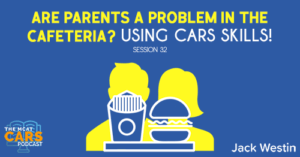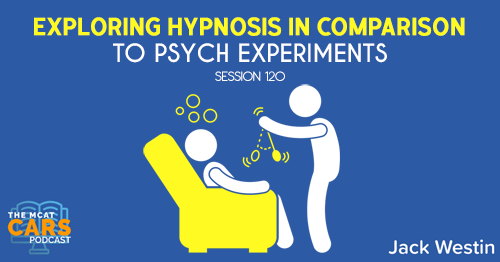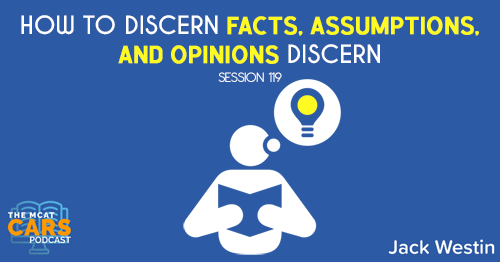Apple Podcasts | Google Podcasts

Session 32
This week, we are breaking down another article that presents competing themes in relation to school lunch. So be sure to look for that theme. What’s the argument? What’s going on? How is the author debating this? Pay attention to the tone as well.
We’re joined by Jack Westin, the world’s premier MCAT CARS tutor.
The MCAT goes deeper than you may expect. Jack explains students may usually stay away from literal answer choices. But that’s not only true.
'Sometimes literal answer choices are correct. You just have to read the passage to make sure.'Click To TweetAlso, be sure to check out Meded Media. We have the resources you need to help you rock your MCAT so you’re one step closer in your journey towards becoming a physician.
Link to article:
The grade-school lunchroom has long acted as a microcosm of social life. It’s where kids choose whom to sit with, develop friendships, and resolve conflicts. And lunch is one of the few less-supervised periods in most kids’ school days. Over the past several years, however, some school cafeterias have become invaded by a new group: parents.
Twenty years ago, when I was in elementary school, having a parent join you at the lunch table was unthinkable. Parents or caretakers dropped everyone off in the morning for school, leaving us to grow, play, and learn until we were collected. But lately, parents are playing a much more active role in their children’s educational lives. According to a September report from Child Trends, a nonprofit research organization focused on children and their family, parental involvement in school is rising. “In 2016, the percentages of students whose parents reported attending a general meeting at their child’s school, a parent-teacher conference, or a school or class event reached their highest recorded levels,” the report states.
At some schools, swarms of parents wait in line to be escorted into the lunchrooms and sit with their children, some as old as 10, for a meal. One school district in Darien, Connecticut, found its cafeterias so inundated with parents that this week it announced an outright ban on parent-student lunches. “It feels like a punch in the gut,” Jessica Xu, a parent whose oldest child is in first grade, told the Associated Press after learning of the decision. “I chose the town for the schools. I’m so frustrated the schools don’t want me there.”
As the number of parents joining their kids for a midday meal swells, schools have tried to be accommodating. Most schools value parent involvement, but at a certain point it can become disruptive. A middle-school teacher in Connecticut, who asked to be anonymous since she was not authorized to speak on the record, said that she doesn’t think parent-student lunches are a bad thing, but she has seen them cause issues in the past. “The parents would bring pizza for some students and not others. It became a little bit of a circus and I do remember feeling like it was disruptive instead of being just a sweet lunch between just the mom and the kid,” she said. “I think she was using lunch to try to buy her daughter friends,” the teacher said of one mom.
Some kids, especially the young ones, begin crying when their mom or dad attempts to leave after lunch. Other children whose parents aren’t able to visit them (possibly because they’re working) can be left feeling neglected. School districts have attempted to thwart these problems by forcing parents to sit with just their own children, sometimes in separate rooms or areas. Rogers Middle School in Texas even offers parents and children the opportunity to dine at a “bistro” with fancy-looking chairs to avoid lunchroom disruption.
[03:33] Paragraph 1, Sentence 1
The grade-school lunchroom has long acted as a microcosm of social life.
Jack says:
Microcosm is when you see something in a small way but it represents a bigger picture.
[04:08] Paragraph 1, Sentence 2
It’s where kids choose whom to sit with, develop friendships, and resolve conflicts.
Jack says:
It’s explaining who you’re going to be friends with and how you’re going to resolve that.
[04:30] Paragraph 1, Sentence 3
And lunch is one of the few less-supervised periods in most kids’ school days.
Jack says:
It paints a picture of what the lunch room looks like.
[04:40] Paragraph 1, Sentence 4
Over the past several years, however, some school cafeterias have become invaded by a new group: parents.
Jack says:
It creates this dichotomy of situations where kids are alone, growing, and resolving things on their own. And now you’ve got parents involved.
[05:40] Paragraph 2, Sentence 1
Twenty years ago, when I was in elementary school, having a parent join you at the lunch table was unthinkable.
Jack says:
Kids would even tell parents to drop them off three blocks away from school since they don’t want to be seen with their parents.
[05:55] Paragraph 2, Sentence 2
Parents or caretakers dropped everyone off in the morning for school, leaving us to grow, play, and learn until we were collected.
Jack says:
The author is just painting a picture of what parents are basically there for.
[06:10] Paragraph 2, Sentence 3
But lately, parents are playing a much more active role in their children’s educational lives.
Jack says:
Twenty years ago, the theme was that parents were not involved. Now, they are. The debate the author is trying to put into perspective is whether this is a good thing.
'Everything is always in terms of good or bad.'Click To TweetThe purpose of the passage is to convince us whether we should do this or do that. Is this good or bad?
Ask yourself whether it’s a good thing or a bad thing. And the author always has their opinion on it. You just have to listen.
[07:22] Paragraph 2, Sentence 4
According to a September report from Child Trends, a nonprofit research organization focused on children and their family, parental involvement in school is rising.
Jack says:
The author is giving data showing that parents are getting more involved.
[07:42] Paragraph 2, Sentence 5
“In 2016, the percentages of students whose parents reported attending a general meeting at their child’s school, a parent-teacher conference, or a school or class event reached their highest recorded levels,” the report states.
Jack says:
The author is further explaining what that involvement looks like.
The big picture of this paragraph is that parents are getting more involved with their kids at school. Whether this is a good thing or a bad thing, we don’t know. So don’t bring in your bias.
[08:47] Paragraph 3, Sentences 1-2
At some schools, swarms of parents wait in line to be escorted into the lunchrooms and sit with their children, some as old as 10, for a meal. One school district in Darien, Connecticut, found its cafeterias so inundated with parents that this week it announced an outright ban on parent-student lunches.
Jack says:
One school is banning it because it’s inundated. Too many parents are showing up. It sounds negative since it says “swarms” and “inundated.” At this point, it probably leaning towards the negative. We don’t know for sure yet though.
[10:03] Paragraph 3, Sentence 3
“It feels like a punch in the gut,” Jessica Xu, a parent whose oldest child is in first grade, told the Associated Press after learning of the decision.
Jack says:
One parent is saying how it’s a punch in the gut that they’re being banned. This is a negative thing. She obviously doesn’t like the decision. It’s showing us how parents want it and maybe schools don’t want it since they’re banning it. Again, we see this competing theme. Is it good or bad?
[10:40] Paragraph 3, Sentence 4
“I chose the town for the schools. I’m so frustrated the schools don’t want me there.”
Jack says:
It’s a quote from the same parent. She chose the town because of the school and now the school doesn’t want her there. This is bad from her perspective.
[11:09] Paragraph 4, Sentence 1
As the number of parents joining their kids for a midday meal swells, schools have tried to be accommodating.
Jack says:
The author points out how parents want to be there for their kids and some schools are trying to accommodate that.
[11:24] Paragraph 4, Sentence 2
Most schools value parent involvement, but at a certain point it can become disruptive.
Jack says:
This is the first negative aspect here. Schools want involvement but it may not be good.
[11:43] Paragraph 4, Sentence 3
A middle-school teacher in Connecticut, who asked to be anonymous since she was not authorized to speak on the record, said that she doesn’t think parent-student lunches are a bad thing, but she has seen them cause issues in the past.
Jack says:
Again, these lunches can be an issue based on the comment of the teacher.
[12:07] Paragraph 4, Sentences 4-6
“The parents would bring pizza for some students and not others. It became a little bit of a circus and I do remember feeling like it was disruptive instead of being just a sweet lunch between just the mom and the kid,” she said. “I think she was using lunch to try to buy her daughter friends,” the teacher said of one mom.
Jack says:
The author is just saying how this can become an issue. This is bad picture here showing the parent is a manipulative person. Disruptive is the key here. Keep in mind the “bribery” here where the parent is giving something to kids so they’d make friends with her kid. This isn’t direct but implied.
[13:35] Paragraph 5, Sentence 1
Some kids, especially the young ones, begin crying when their mom or dad attempts to leave after lunch.
Jack says:
The author depicts more disruption that takes place because of the presence of parents.
[13:48] Paragraph 5, Sentence 2
Other children whose parents aren’t able to visit them (possibly because they’re working) can be left feeling neglected.
Jack says:
So there are kids upset because parents are leaving. There are also kids being upset because parents aren’t coming.
[14:10] Paragraph 5, Sentence 3
School districts have attempted to thwart these problems by forcing parents to sit with just their own children, sometimes in separate rooms or areas.
Jack says:
This is some alternative that schools are trying to work on to prevent issues.
[14:28] Paragraph 5, Sentence 4
Rogers Middle School in Texas even offers parents and children the opportunity to dine at a “bistro” with fancy-looking chairs to avoid lunchroom disruption.
Jack says:
This is an example of one school going above and beyond to fix this disruptive behavior.
[14:50] The Key Takeaways
The author is probably saying it’s disruptive. Although the tone is neutral. This is an important lesson. Tone is not necessarily what we’re saying but how we say it.
For instance, when you say “ice cream is good.” This is not positive. It’s just you saying that ice cream is good. But if you want to bring in a positive angle, you can elevate the tone and say “ice cream is amazing.”
The difference between amazing and good is the tone. They’re both saying it’s good, just one is saying it a very extreme manner.
Tone is really extreme language. There’s no extreme language here. The author is just saying that it’s disruptive. It’s not good. But it’s not negative in tone.
Hence, the author may not necessarily be “for parents,” but also not necessarily very extreme.
[07:10] Jack Westin
Check out Jack Westin and sign up for his free CARS Passage of the Day. Have it delivered right to your inbox. Read the passage from there and answer the questions for free – everyday.
Links:
Link to article:
SEARCH SITE
SEARCH SITE
LISTEN FOR FREE











